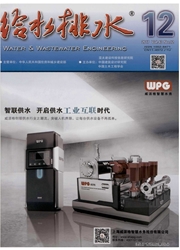

 中文摘要:
中文摘要:
以珠江水为原水,利用微絮凝一大梯度磁滤工艺对水中消毒副产物前驱物进行处理,研究工艺的磁场强度和磁滤速度的变化对消毒副产物生成势(THMFP)和UV254的去除效果影响。研究发现,去除THMFP以去除三氯甲烷生成势为主;THMFP的去除效率随着磁场强度的升高或滤速的降低而升高,在磁场强度为0.23T时达到最高为47.83%,磁滤速度为6~8m/h时,去除率稳定在46%左右;UV25。的去除效果受滤速的影响较大,滤速从6m/h提高到16m/h时,去除率从57.56%下降到39.58%,而磁场强度的变化对UV254的去除效率影响较小,去除率稳定在46.0%~50.7%。
 英文摘要:
英文摘要:
Disinfection by-products precursors in raw water from the Pearl River was treated by microflocculation-great gradient magnetic filtration process. The removal effects of variation of magnetic field intensity and filtering velocity were studied on the treatment of trihalomathanes for- mation potential(THMFP) and UV254. It was found that the removal of THMFP was mainly to re- move trichloromethane formation potential in water. The removal effect of THMFP increased un- der the increasing of magnetic field intensity and the decreasing filtering velocity, the removal effect reached to the peak of 47.83 % when the magnetic field intensity was 0. 23 T and the removal effect stabled at around 46 % when filtering velocity was between 6 m/h and 8 m/h. The filtering velocity had a large influence on the removal effect of UV254, with removal effect decreased from 57.56% to 39.58%, while the magnetic field intensity had a little influence on the removal effect(46. 0%-50. 7%).
 同期刊论文项目
同期刊论文项目
 同项目期刊论文
同项目期刊论文
 期刊信息
期刊信息
